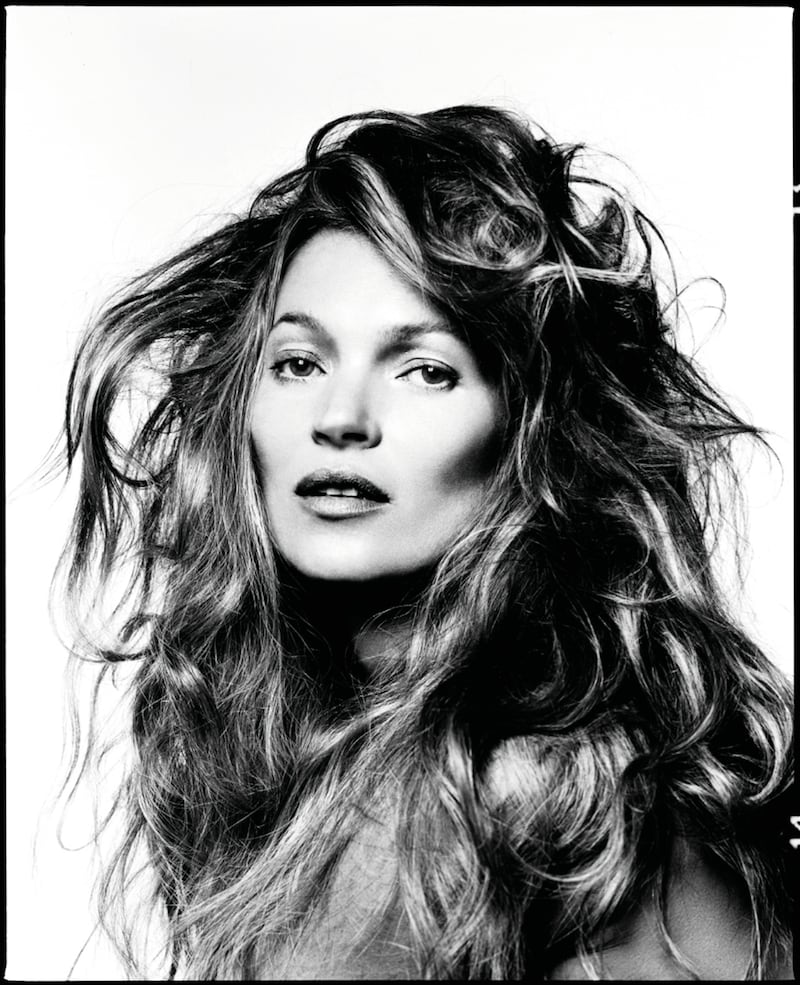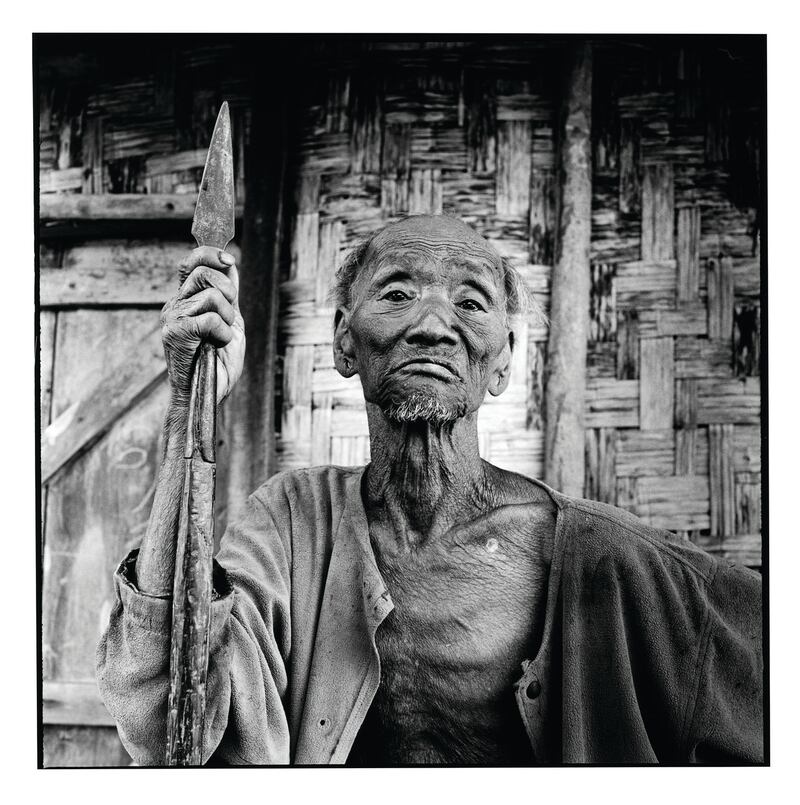
Some of his philanthropic efforts are a little more light-hearted. As part of his Democracy project, Bailey offered to photograph visitors to his studio buck-naked from 2001 to 2005—an invitation, incidentally, none ever refused. One by one, he asked his subjects to strip and stand in front of an evenly lit, white background, a mere six feet from his lens; once photographed, every image was printed on the same paper, free from edits, and identically framed. The point? To enforce democracy. Bailey banished variation other than that embodied in the sitters themselves. Six of the resulting life-size nudes hang in the Gallery, and, like the images of nameless subjects from his travels, they highlight the personalities of the sitters who arrange their bodies in certain ways. Model Bernd Kho stands legs-spread, fingers pinching nipples, clearly well within his comfort zone, a smile playing across his lips. Tattoo- and piercing-covered, “Prince Albert” is even easier to read. As Bailey said, “you could hire him for parties!” Who doesn’t love a good exhibitionist?
“Just a little bit of pixie dust”—that’s all Peter Pan needed to fly to Neverland. For Londoners lucky enough to find their way to the National Portrait Gallery, the magical substance guaranteed to provide a lift is Bailey’s Stardust, the ultra glamorous photographs by David Bailey.
On display until June 1, Bailey’s Stardust is a large-scale exhibition involving over 300 portraits, the majority of them newly printed for the occasion. A British fashion photographer who transcends the genre, 75-year-old Bailey selected the images himself, making curatorial choices that illuminate his career spanning half a century.
ADVERTISEMENT

The images—whose subjects and sitters range from the celebrated to the unknown—are grouped by theme and presented in a series of contrasting rooms. Despite these thematic divisions, the exhibition still flows: photographs in brilliant color hang beside silver gelatin prints of Bailey’s iconic black-and-whites; formal commissions accompany candid shots of unpredictable daily life.
Designer Hugo Boss sponsored the exhibit, so it’s no surprise to find Kate Moss greeting visitors upon entry. Never before seen, this monolithic black-and-white portrait focuses on Moss’s face and hair, a glorious, glistening, tousled mane. Did Bailey foresee his muse’s next act as contributing fashion editor to British Vogue? The portrait certainly suggests there’s more to the model than cheekbones—Moss looks visitors in the eye and lets them know that she is the whole package: beauty and brains.
It was his own work for Vogue in the early 1960s that put Bailey on the map, and fashion photography has remained an important part of his repertoire ever since. A host of fashion and editorial-like portraits follow Moss’s lead; turn left or right down the exhibition’s central hallway, and from either side a cast of familiar faces returns your gaze.

Portraits of the Rolling Stones and other easily recognizable stars populate the small, alcove-like room straight ahead. Bailey first met Mick Jagger when the musician was dating the sister of Jean Shrimpton, who was Bailey’s roommate (and girlfriend) at the time. There are solo portraits of Jagger and group shots of the band taken backstage during various tours in the early-1970s, as well as images of their iconic album covers.
Visual artists also play a prominent part in the exhibition. A multitude of painters, film directors, and fellow photographers have subjected themselves to the scrutiny of Bailey’s lens. An extreme close-up of Man Ray snapped in profile (1968) hangs opposite a nonchalant-looking Andy Warhol (1965). An image of Richard Hamilton (2003) doubles as an advertisement: Hamilton has a retrospective opening at the Tate Modern next week.
The engagement between Bailey and his subjects is palpable, and seductive. He makes the viewer wonder about his relationship with each of the sitters. Francis Bacon is a case in point. In the exquisite exhibition catalogue, Bailey reveals, “He tried to pick me up when I was twenty-one.” But in the portrait, Bacon looks anything but interested. Bored, in fact, as if waiting for Bailey to take the photo, head propped up lazily on his hand.
There’s less mystery in his relationship with his fourth wife, Catherine Dyer, to whom he dedicates an entire room. The pair met in 1983, married three years later, and together share three children—Paloma, Fenton, and Sascha, also pictured in the show. An array of portraits of Catherine—herself a model with the natural ability to pose—form a photomontage-like display. Each image captures her in a different context and guise—sometimes clothed, sometimes not; in some cases maternal, in others erotic. Whatever persona she adopts, Dyer is framed lovingly by her husband.
The more personal portraits are not the only ones that tell a tale. Despite the starry title, Bailey’s Stardust is more than a who’s who of the fashion elite. Bailey brought his camera on his travels to Africa, Australia, India, and Papua New Guinea. Whereas the famous faces from London, Paris, New York, and Los Angeles are named and dated, the characters he photographed in distant lands stare out in anonymity. Viewers won’t recognize them, but their powerful images form a connection of shared humanity between the obscure and the famous.

Delhi is the exotic destination Bailey visited most often. Just as he reveled in London’s runway-like streets, he found inspiration in Delhi’s rundown ones—images taken in 2011 reveal his fascination with grit and grime. He took striking photos in Sudan and Ethiopia of refugees fleeing from the famine and civil war, powerful black and whites of holy men, and vibrant digital color shots of ancient artifacts.
Bailey also photographed the stars performing in Bob Geldof’s Live Aid concert, high-profile musicians who used their lungs to help raise money for charity. Through his art, Bailey drew attention to poverty and despair in faraway places.
Thirty-six black-and-white photographs—here grouped in six frames of six—are taken from Bailey’s Box of Pin-Ups. They hang alongside his Democracy pictures as a clothed contrast. Bailey explained his choice of sitters, saying, “They were mostly mates—they were the easiest ones to get!” Fortunately for him, his “mates” happened to be some of the most fashionable cultural figures of the day. Stepping up to the plate were John Lennon, Paul McCartney, and Lord Snowden, to name just a few.
The exhibition also includes a number of images that illustrate London life in the 1960s. Color portraits published in The Sunday Times Magazine feature “East End Faces” (1968) made in pubs, clubs, gyms, and cafes. Snapshots of artsy East-London hangouts in Bethnal Green, Brick Lane, and Whitechapel betray Bailey’s nostalgia for his bohemian youth.
Despite these historical allusions, no one can accuse Bailey of being stuck in the past. A room called “Camera Phone” is the most obvious indication that he is keen to explore the possibilities of new technology. The images adorning these walls contribute a welcome bout of color to a show dominated by black and white. A portrait of Surrealist Salvador Dalí reflected in a mirror gives a quiet nod of approval to popular new trends: even this giant of twentieth-century art indulged in a selfie of sorts.
The National Portrait Gallery was the first museum to show Bailey’s photographs, at an exhibition called Snap in 1971. The title of his new show was inspired by Bailey’s favorite song, Hoagy Carmichael’s Stardust, the old standard about love captured in a melody. Is it too corny to think of Bailey capturing love with the click of a shutter? Glamor—Bailey’s strong suit—is never corny.
Bailey’s Stardust is at London’s National Portrait Gallery from February 6—June 1, 2014.





